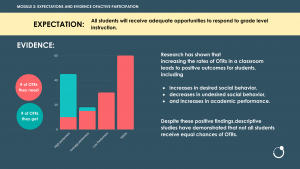“No one rises to low expectations.”~Les Brown
What is Neurodiversity and Why It Matters
New learning approaches and tools are needed to meet the growing diversity in today’s classrooms. Gone are the days of the industrial age educational system that had the goal of teaching to the needs of the “average” student. The focus is changing from teaching to the “average” to more personalized learning. This focus recognizes that students learn differently and are neurodiverse. In light of the current educational landscape, understanding how students learn differently is now more important than ever.
The term neurodiversity was first introduced by Judy Singer in the late 1990s. Singer, a sociologist on the autism spectrum who believed that she was not disabled but just had a brain that worked differently from typical people.
According to The Growing Diversity in Today’s Classroom,” an educator in the 1970s or 1980s with a classroom of 24 students might have had five or six students (20 to 34 percent) requiring specialized interventions. In a classroom of 24 students today, between 10 and 12 students (40 to 50 percent) are living in poverty, have a disability or learning difference, are English language learners, are gifted or talented, are experiencing challenges at home or in their communities that result in trauma, or some combination of the above.” All of which is likely to be a bigger concern the more time they spend away from school.
Experienced educators are expressing their concerns about being able to meet the needs of neurodiverse students without adequate professional learning and resources. According to the “Opportunity Myth, 2018,” of the 180 classroom hours in each core subject during the school year, students spent 29 hours on lessons with strong instruction and 151 hours on lessons with weak instruction. So, what do exemplary neurodiverse schools look like and what are they doing that is working?
Exemplary schools serving neurodiverse students all have the following in common: significant gains in all subgroups, overall high proficiency, and lasting growth. They also have these 4 success indicators.
Success Indicators of Exemplary Schools
- The curriculum is based on the state’s standards
- Grade level instruction and assignments based on the state assessment design
- Purposeful high-yield evidence-based practices
- A proven framework for giving all students optimal opportunities to respond
What will exemplary schools do to start this next school year?
Educators and administrators are aware of the summer slide. However, during the 2019-20 school year, more than summertime has been lost. For many students, the ability to catch up will be a challenge. In the recent study, “The Opportunity Myth 2,” the study found that “meeting students where they are” practically guarantees the loss of more academic ground and perpetuates the belief that students are unable to do grade-level work.
- Present Grade-level Goals and Tasks
These exemplary neurodiverse schools will be ready on day one by providing acceleration opportunities and exposing students to grade-appropriate work sooner rather than later. This approach is extremely different from what most school systems will do. Most school districts will engage in a form of remediation designed to address unmastered skills. This approach creates a cycle of off-grade level work that the student can’t ever escape which leads to a lowering of expectations.
2. Provide Multiple Response Opportunities.
Exemplary neurodiverse schools pay close attention to the number of response opportunities students receive. In this slide taken from Dot IT Professional Learning Series: Expand Your Evidence, educators learn how many opportunities to respond (OTRs) are needed for students to understand grade-level content.

3. Monitor and Praise Success
Instead of negative consequences for wrong answers, educators in exemplary neurodiverse schools encourage failures as learning opportunities. Their feedback emphasizes both effort and outcomes. Appropriate feedback gives students the help they need to improve their performance by letting them know where they are now and where they need to go.
Everyone has responded with the best of intentions and extraordinary effort during this last school year. Assume that will continue as you plan for whatever the 2020-21 school year brings.






